

01 INNOENERGY’S IMPACT


FOREWORD

Elena Bou Co-Founder and Innovation Director, InnoEnergy
14 years of fostering innovation for growth and decarbonisation: what lies ahead?
Political winds are shifting, and capital markets are passive. Yet, the need for clean tech innovations to power our global energy demand has never been bigger or more important. As global energy demand continues to rise, the challenge is not just to decarbonise but to do so while ensuring security of supply.
Clean tech innovations have boomed over the past decade and a half. Today, these technologies integrate with the existing energy industry, gradually transitioning it to become sustainable. No longer a niche play or a costly green premium, these innovations are now integral to the energy system, reshaping entire industries and emerging as the economically rational choice. From electrification in transport to green hydrogen in heavy industry, clean tech is not just an alternative; it is becoming the default. The question is no longer whether the transition will occur, but rather how quickly and which economies will lead it.
The success formula for growing clean tech innovations at scale is in the ecosystem. Transitioning to clean energy is not a siloed effort; it requires alignment on global policy, the startup community, global investors, academia, and the existing industrial base.
Public policy is a key driver of the energy transition. In the European Union, legally binding climate commitments and sectoral targets offer businesses and investors the regulatory certainty needed to drive the shift to net-zero. InnoEnergy supports the development of strong energy and industry policies that pave the way for new business models in clean energy, such as tidal or wave energy.
Building on this foundation, we prepare the current and future workforce, support clean tech companies, lead clean tech industrial value chains, and build the largest and most diverse clean tech ecosystem.
Building on this foundation, we prepare the current and future workforce, support clean tech companies, lead clean tech industrial value chains, and build the largest and most diverse clean tech ecosystem.
People
The clean energy transition centres around people. People bring new ideas, make decisions that impact our future, and turn visions into reality. Our priority is to provide opportunities for people to succeed in shifting our economy to net-zero. Whether that be educating the leaders of tomorrow, upskilling today’s talent for industry, or recruiting startup teams.
Clean tech companies
We have supported over 540 clean tech companies and continue to invest in new innovations. Four of these have grown into unicorns. These companies push boundaries and enable the alternatives that the energy transition needs to succeed. Our role is to identify the most relevant innovations, help them grow and find commercial traction, and set them up for a successful scale-up.
Clean tech industrial value chains
Our holistic focus on the energy transition includes shaping markets for clean tech industries to develop. We lead three strategic value chains in battery storage, green hydrogen, and solar photovoltaics and impact more sectors. We influence their strategic directions to accelerate the energy transition more effectively.
Ecosystem
We have developed the largest and most diverse clean innovation ecosystem. Today, more than 1,400 partners from industry, public and private investors, public policy, and academia with different expertise and experience work together to accelerate time-to-market, de-risk, and increase our portfolio companies’ impact.
Same mission. Higher ambitions.
Now, as the energy transition is underway, our ambitions continue to increase. Shifts in global geopolitical dynamics, a maturing clean tech industry, and a larger-than-ever clean energy demand set the stage for the next phase of work. With a proven track record and a strategic position at the heart of Europe’s clean tech ecosystem, we are ready to scale the transition globally. This report proves that we have generated an impact over the past 14 years.
Our work to keep increasing impact continues, and on the following pages, you can learn how we transition global energy and enable the transformation of every industry.

WHAT THEY SAY ABOUT US

Maroš Šefčovič Commissioner for Trade and Economic Security
“What I appreciate about InnoEnergy is its tailor-made support to help entrepreneurs develop promising and efficient energy solutions while always mindful that they have to conquer markets. InnoEnergy had a decisive role to play by being an enabler of the Energy Union through innovation.”

Irene Galvez Head of Cleantech Growth Capital Division. European Investment Bank
“As a valued partner of the European Investment Bank and with a track record of successful co-investments in cleantech ventures over the years, InnoEnergy manages to bring together an array of investors effectively. In InnoEnergy’s ecosystem, strategic industrials and innovators together propel the European energy champions of tomorrow."

Steffen Grosse CEO Equity Finance, Siemens Financial Services
“Transforming towards a sustainable world requires both innovative technology solutions and the necessary financing. As a strategic investor and technology partner, we at Siemens Financial Services understand that the next phase of the energy transition can only succeed through connecting the right people, financial resources and innovative technology. InnoEnergy has created a cleantech innovation ecosystem that enables this vital combination. Their holistic approach drives the necessary transformation we need to sustainably use our resources and successfully shape the future of energy transition.”

Olivier Clyti Director of Strategy R&D and Innovation, InVivo Group
“At InVivo, we recognise the need for greener fertilisers, with production processes that have a reduced carbon footprint. Through the expertise and ecosystem of InnoEnergy, we’ve successfully formed a strong consortium of partners to make this vision a reality. FertigHy will leverage renewable energy to produce sustainable fertilisers, reinforcing food sovereignty and enhancing agricultural resilience. This groundbreaking project will enable us to produce larger quantities of high-quality fertilisers in an environmentally responsible way. Together, we are shaping the future of sustainable agriculture.”

Gwenaelle Avice Huet
Executive Vice President, Europe Operations, Schneider Electric
“We need policies that foster innovation spending. We need InnoEnergy to help. Startups must be able to believe Europe is the place to be because investments will be fulfilled. Large companies must accompany this.”

Marcel van de Kar
Senior Vice President Hydrogen & CO2, Vopak
“Through the collaboration with InnoEnergy, we have identified several promising startups with whom we are currently developing pilots. We have also invested in some of these companies. This is part of our strategy to position Vopak as a major energy player in the world of tomorrow.”

Bastien Gambini
Managing Partner at Klima, Alantra
“For a growth investor such as Klima, being part of the InnoEnergy ecosystem has always been of good value to our activities, not just as a qualified deal flow source but also because of its systemic role. InnoEnergy is one of the few early-stage pan-European cleantech players and has been committed to the sector for over 15 years. It makes them a structural element of that ecosystem. And of course, as an earlier stage investor, InnoEnergy nurtures and grows opportunities that come later to our growth stage focus with a differentiated quality stamp – article 9 qualified, management teams aware of requests and asks of investment funds, reporting standards, etc.”

Herbert Fikkers Director, ING Sustainable Investments
“At ING, we are dedicated to driving sustainable progress and fostering innovation in society and the energy sector. As a shareholder of InnoEnergy, we recognise the value and importance that the ecosystem of InnoEnergy brings to our shared vision of the future. ING's focus on sustainability, innovation, and financial expertise aligns with InnoEnergy's mission to accelerate the transition to sustainable energy. Our ambition to provide tailored financing solutions and support the transition complements InnoEnergy's pioneering efforts in developing and scaling clean energy technologies. We are grateful for this partnership and for being part of driving the energy transition.”
2023-2024 KEY ACHIEVEMENTS
SANTANDER INNOENERGY
CLIMATE VC FUND LAUNCHED IN 2023
Read more →
THE LAUNCH OF THE INNOENERGY SKILLS INSTITUTE
Read more →
INNOENERGY ANNOUNCES NEW INITIATIVE TO SPEED CLIMATE NEUTRALITY, BY DEVELOPING €100
BILLION A YEAR GREEN HYDROGEN ECONOMY BY 2025
Read more →
INNOENERGY SECURES OVER €140 MILLION IN PRIVATE PLACEMENT ROUND
Read more →
EUROPEAN SOLAR PV INDUSTRY ALLIANCE SECURES OVER 110 MEMBERS TO LAUNCH INDUSTRIAL ACTION PLAN TO RESHAPE INDUSTRY
Read more →
THE EUROPEAN COMMISSION RENEWS PARTNERSHIP WITH INNOENERGY’S EUROPEAN GREEN HYDROGEN ACCELERATION CENTER TO ACCELERATE AND DE-RISK GREEN HYDROGEN INITIATIVES
Read more →
OMV, OMV PETROM, AND ACB PARTICIPATIES B.V JOIN AS SHAREHOLDERS, TOPPING UP SUCCESSFUL €140M PRIVATE PLACEMENT
Read more →
2024: 14 NEW PORTFOLIO COMPANIES AND €9.8B RAISED FOR CLEAN TECH PORTFOLIO
Read more →
LEADING POLISH INDUSTRIAL GROUP BORYSZEW S.A. BECOMES A SHAREHOLDER IN INNOENERGY
Read more →
INNOENERGY
ANNOUNCES NEW BRAND AND PLANS TO MOBILISE UP TO €160BN IN CLEAN TECH INVESTMENT BY 2030
Read more →
#1 MOST ACTIVE VC INVESTOR GLOBALLY IN ENERGY IN 2024 AND 2023
According to Pitchbook's Global League Tables.
Read more: 2024 → 2023 →
02 IMPACT KPI'S FROM PORTFOLIO COMPANIES

Head in the clouds. Feet on the ground.
IMPACT KPI’S

The energy transition is more than an environmental imperative – it’s the basis for a profound industrial, economic and societal transformation that requires bold action to ensure clean tech innovation is scaled at speed. Through our diverse portfolio of start-ups, which includes a solid pipeline of clean industrial ventures, we are signalling to investors, innovators, policymakers, and industrial leaders: we are here to lead, to partner, and above all, deliver impact.
Elena Bou Co-Founder and Innovation Director, InnoEnergy

For us, impact is not just a goal, it’s built into everything we do. We know first-hand that the energy transition and industrial transformation are not a ‘walk in the park’. At InnoEnergy, we are staying the course, tackling the complexities of industrialising clean technologies head on. Europe has a unique single market, a strong industrial base, and the most ambitious and stable regulatory framework reaffirmed by the Clean Industrial Deal. With a maturing pipeline of clean industrial newcomers ready to scale and serve the domestic demand, we are pushing ahead and delivering impact.
Diego Pavia CEO, InnoEnergy

Economic impact
Accumulated by 31 December, 2024
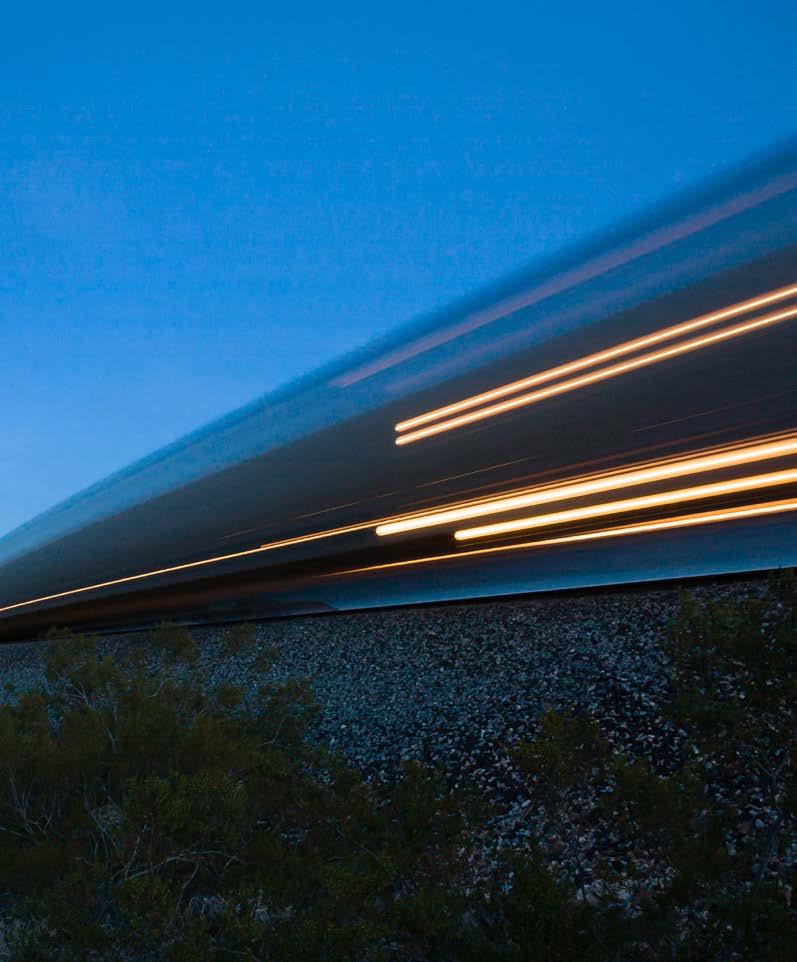
47,760
Direct & indirect jobs created
Social impact
Accumulated by 31 December, 2024
€ 943M
Actual revenue generated by portfolio companies
€34B+
Investment raised by portfolio companies
2,457
# of female entrepreneurs
80 Nationalities and an average of 5.6 nationalities per company
2.9M
People with access to energy in developing countries
Environmental impact
Potential contribution, accumulated estimation by 2030
2.3 Saved
534M
Equivalent to 534m of ICE cars driven for one year
€ 13.5B Of energy cost savings
277 Generated from clean energy sources Gt CO2e TWh
163M
Equivalent to consuming Australia's 2024 oil production of 163m of barrels of oil
IMPACT FRAMEWORK
Rooted in a strong partnership
InnoEnergy is a long-standing partner of the European Union to help deliver and implement clean energy and industrial transition goals. We support strong and robust policies to decarbonise faster, strengthen a competitive and resilient Single Market, and ensure citizens benefit from the clean transition.
We turn decarbonisation and reindustrialisation policy ambitions into market reality by investing in clean tech innovations that reduce greenhouse gas emissions, support competitive growth, and create quality jobs across Europe. We strengthen European energy security and sovereignty by investing in Made-in-Europe companies to boost domestic manufacturing capacity. We actively support a just and inclusive transition by training today and tomorrow’s workforce to work in clean tech sectors, help address regional labour shortages and ultimately ensure citizens benefit from the energy transition.
The EU’s recently released Clean Industrial Deal confirms that decarbonisation and competitiveness go hand-in-hand, placing clean technologies at the heart of Europe’s strategy for economic growth. President Ursula von der Leyen outlines the EU’s commitment to clean tech:

We have a once in a generation opportunity to show the way with speed, ambition and a sense of purpose to secure the EU's industrial lead in the fast-growing net-zero technology sector. Europe is determined to lead the clean tech revolution. For our companies and people, it means turning skills into quality jobs and innovation into mass production, thanks to a simpler and faster framework. Better access to finance will allow our key clean tech industries to scale up quickly.
Ursula von der Leyen President of the European Commission
CONTRIBUTIONS TO EU TARGETS
TAXES REINDUSTRIALISATION & GDPGROWTH TAXES
TALENT&WORKFORCE
SHAREHOLDERS, PRIVATE INVESTORS
VC COMMUNITY AND PUBLIC AND PRIVATE INVESTORS
CORPORATES, SMES, AND INNOENERGY PARTNERS
InnoEnergy’s impact framework
Core business
Social/macro ecosystem
National government
InnoEnergy ecosystem Job market
Energy challenges
EIT InnoEnergy’s impact framework
CORE BUSINESS EIT INNOENERGY ECOSYSTEM SOCIAL/MACRO ECOSYSTEM
NATIONAL GOVERNMENTS ENERGY CHALLENGES JOB MARKET

A trusted ecosystem delivering value
InnoEnergy’s trusted ecosystem is a catalyst for meaningful transactions that drive the energy transition forward. Our work's impact reaches beyond our core business to our extended network of partners and stakeholders, and ultimately, society at large. In this framework, value and impact have broad meanings. We are committed to positively impacting the planet (environment) and people (society) as we continually solve problems that matter. Consequently, profits (economic) can be reinvested in innovations and continuously improve the way we fuel our energy demand and quality of life.
Impact methodology
One key challenge in sustainable investments is establishing a robust operational methodology for measuring and monitoring impact. Our impact methodology interweaves the United Nations Sustainable Development Goals (SDGs) with a selection of Environmental, Social and Governance(ESG) factors aligned with InnoEnergy’s strategic goals, creating a dual alignment that underpins InnoEnergy’s impact measurement framework.
This framework enables us to systematically assess and categorise our investments based on their contributions to specific impact objectives. It also allows us to quantify the impact generated by our portfolio companies, thereby supporting the achievement of InnoEnergy’s

In the Impact Report 2024, we further refined our impact measurement methodology to provide a more detailed representation of our portfolio companies' contributions. Our approach integrates quantitative and qualitative metrics, ensuring a holistic view of our impact across economic, social, and environmental dimensions. We have collaborated closely with our portfolio companies to gather comprehensive data, which has been meticulously validated by our internal team. Our commitment to transparency remains unwavering, and this report underscores our dedication to driving sustainable growth and innovation.
Jordi Daunis Investment and Asset Manager, InnoEnergy

broader strategic goals. Under this framework, we apply a set of defined metrics to evaluate the aggregated impact of our portfolio across three core dimensions: Economic (Profit), Social (People), and Environmental (Planet).
Impact measurement
The impact measurement approach for this report is twofold: first, all our portfolio companies’ contribution to the SDGs. Second, the quantification of impact metrics (economic, social, and environmental) aggregated from all companies in our portfolio which received support from InnoEnergy from 2023 to 2024. Companies that left our portfolio before 2023 were not considered in this reporting cycle, but new early-stage companies joining our portfolio were included. This aspect directly affects the final figures presented, as more mature companies leave our portfolio, and new contributors have a longer time to impact. Market conditions also affect the projections of some startups for different reasons, which is equally reflected in their contribution to the timeframe defined in the impact framework.
The timeframe considered in the calculations is 2030 for cumulated environmental-related impact indicators, while realised impact has been considered for economic and social dimensions. The figures presented in the report are based on data directly provided by the companies in our portfolio as of 31 December 2024. An internal team reviewed and challenged the data, which was then aggregated and consolidated afterwards. Outliers were not considered to avoid distorting the final aggregated numbers. When some environmental indicators were unavailable directly from the company, different measurement tools were used in conjunction with the company when possible and complemented with public sources of information when available to present more comprehensive results.
INVESTMENT PROCESS
Investment approach Selection
At InnoEnergy, we look for highimpact and scalable solutions that can solve global challenges by reducing CO2 emissions, reducing the energy costs along the energy value chain, or making the energy system more reliable, secure, and sustainable. Our investments aim to accelerate the energy transition and generate socio-economic and environmental impact.
Our focus is on investing in highly innovative early-stage companies, usually in pre-seed or seed stages, where our hands-on support delivered by our team of 200 professionals and our trusted innovation ecosystem creates the most value. This approach differentiates us from other investors and enables our portfolio to bring their solutions to the market faster, bigger, and de-risked.

Our selection process is structured in multiple stages to ensure a thorough evaluation of each opportunity. It begins with an initial screening phase, during which we identify and shortlist opportunities that align with our investment thesis.
Following this, we undertake a comprehensive assessment that examines the innovativeness of the solution and business model, the market potential, the team capabilities, and the anticipated environmental and economic impact, while creating awareness on ESG risks. This stage not only enables us to form a preliminary evaluation of the investment opportunity but also helps us understand the specific needs of the venture and identify how we can provide hands-on support.
Based on this analysis, we develop a preliminary roadmap outlining key business milestones, which includes mutual commitments from both parties.
The process then advances to an in-depth due diligence phase, where we conduct a detailed analysis of the technology, market dynamics, team competencies, development areas, and business plan. Our investment committee makes the final investment decision, with additional insights provided by external experts who are strategically relevant to the opportunity's development.
Portfolio management Exit
Following our investment, we start the execution phase of the jointly developed roadmap, delivering a tailored value-added support as previously agreed. We maintain a proactive and structured engagement with the portfolio company throughout the holding period, up to the point of exit. We continuously monitor progress across multiple impact dimensions—economic, environmental, and social—ensuring alignment with business objectives and broader sustainability goals.
A core component of our portfolio management approach is support in navigating ESG risks. We work closely with companies to identify, assess, and mitigate ESG-related risks, embedding ESG considerations into their governance and operational frameworks. In parallel, we provide guidance and tools to help companies measure and manage their impact and contribution to the SDGs.
This ongoing collaboration enables our portfolio companies to meet their impact targets and communicate their achievements transparently and credibly. These outcomes are captured and shared through our Impact Report, which reflects the tangible contributions of our investments.

The exit strategy is defined during the selection process. ESG and impact contribution are important elements of that strategy as they help to maximise exit opportunities, from increasing the company's value over the years to finding potential impact-driven buyers.

In our investment process, we place a strong emphasis on the potential impact of the companies in which we invest. ESG considerations are integrated early in the selection phase, where we start by creating awareness about environmental, social, and governance risks and the importance of measuring environmental impact.
These considerations form a core part of our eligibility criteria. Furthermore, our investment agreements include regular impact reporting and data disclosure. Once a company joins our portfolio, we provide structured guidance and support to help them monitor, measure, and enhance their impact. This not only fosters greater ESG maturity but also catalyses sustainable growth.
Jordi Lopez Managing Director of the Innovation Business Line, InnoEnergy
03 OUR INNOVATION SYSTEM
INDUSTRIAL VALUE CHAINS ECOSYSTEM
PEOPLE START-UPS

Together, we make it happen.

InnoEnergy is industrialising clean tech innovation to enable and grow a global net-zero economy. We began when the “energy transition” concept was still in its infancy. Over the past 14 years, we have led the change, demonstrating that we can make the transition a reality.
We drive change through open innovation, basing our business on continuous external involvement and collaborative efforts throughout the innovation process. We have not done this alone; instead, we have built the largest and most trusted clean energy innovation ecosystem, bringing together all players involved in the energy transition. This approach has enabled us to co-create, develop, and scale the most relevant clean technologies.
Our innovation system is built around four key layers: people, startups, industrial value chains, and the broader ecosystem. It is the synergy and interconnections between them that enable clean tech innovations to form, grow, and scale into the new energy standard powering our global energy demand. By amplifying our collective power, igniting opportunities, and adapting at speed, we accelerate the clean energy transition.
PEOPLE
People drive innovation.
That is why we centre our work around providing the opportunities and support people need to bring innovations forward. People are the inner layer—the core—of our innovation system, which expands to include startups, value chains, and the entire ecosystem needed to realise the clean energy transition.
Our students are future game changers. We equip them with the mindset of clean energy as the standard and the skills they need to lead the way. At our Masters+ programmes, they develop an entrepreneurial mindset and expertise in clean technology. When they enter the workforce, they drive the clean tech transition by bringing new ideas to life and changing company cultures from the inside. Graduates are our secret weapon to sustain the transformation of every industry.
When we invest in startups, we invest in their people. We provide founders and their teams with the proper training, talent support, and guidance to develop their teams, businesses, and technologies. Investing in people and with cash, our holistic approach helps founders build stronger business cases, grow faster, and with less risk.
As the energy industry transitions, companies must equip their people with the new skills required. Through our Skills Institute, we upskill talent with critical capabilities, whether for batteries, solar, or other clean energy technologies.

Masters+: Educating tomorrow’s leaders
35%

94%
2,000+
Women students 15%
Students employed within 6 months of graduation
7
Alumni in Forbes 30 under 30
Average annual salary earning over graduates of similar programmes
Graduates of masters+
99
Nationalities represented in our programmes
Value-added support: Developing entrepreneurial teams
144 # of people recruited for portfolio companies 2023-2024
Skills Institute: Upskilling today's talent
600+
Hours of unique content
50+
Industry partners
385+
Founders directly trained in finance, sales, and pitching since 2018
125K+
Workers upskilled
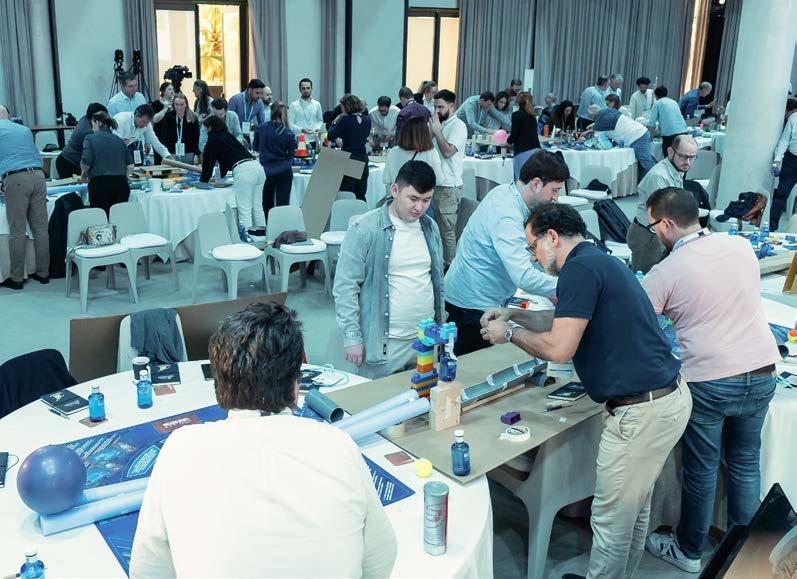
From InnoEnergy
Masters+ to Forbes 30 under 30
InnoEnergy Masters+ alumnus Martim Perestrelo has been named to Forbes 30 Under 30, marking InnoEnergy’s eighth honoree. While studying at KTH and UPC, he co-founded Tether, a startup transforming parked EVs into an AI-powered battery network to stabilise the grid and reduce fossil fuel reliance. Inspired during his thesis at Starke Energy and further developed with co-founder Luis, Tether began after winning the 2022 EIT Jumpstarter. Backed by Techstars and MobilityXLab, Tether secured its first Letter of Intent and funding, turning a student project into a breakthrough energy solution.
Growing a team that will take the company to new heights
Methaplanet needs more talent in key positions to take on the next growth phase. InnoEnergy’s Access to Talent supports finding the right people to fit key roles, including a Technical Project Manager, a Project Engineer, and a CFO. During the recruitment process, conversations naturally span beyond résumés, exploring mission, vision, values, employer brand, culture, and employee value proposition. Focusing on competency-driven selection and the employee experience, using transparent communication, and setting real expectations from the start builds employee engagement and longterm retention.

Next in the Net-Zero Industry Academy: 100,000 workers to be trained in solar energy
Following the success of the European Battery Academy, the InnoEnergy Skills Institute has launched the European Solar Academy. As a flagship programme under the Net Zero Industry Academies, its goal is to upskill 100,000 people for roles across the solar value chain. From manufacturing to installation, the Academy tackles critical workforce gaps in one of Europe’s fastest-growing clean energy sectors. With over 40 certified courses and more than 80 training partners, it supports the EU’s 2030 targets while driving job creation and energy resilience across the continent.

InnoEnergy is a great help as they can practically take over part of our HR function when needed. They know where to look for the right talent and ensure that the candidates understand what it means to work at Methaplanet, our growth phase, and how they will contribute to our next steps. Running an early-stage company requires a lot of different types of work. Having the support to get key talent excited and committed about our journey helps us spend time advancing the technology and developing the company in parallel.
Xander Sandell
Co-Founder and CEO, Methaplanet

Watch Kerstin Jorna's TBB2024 presentation →
There has been a big shift in the skills required. Rather than harmonised qualifications, we created a skills academy, the InnoEnergy battery academy and solar, where you can upskill. We need to know where the skills we need in the future will be.*
Kerstin Jorna
Director-General, European Commission, DG GROW
*speaking at TBB2024
InnoEnergy Skills Institute trains 100,000 for Europe’s battery industry
The InnoEnergy Skills Institute has reached a major milestone, having upskilled over 100,000 people through the European Battery Alliance (EBA) Academy. Launched in 2022 and mandated by the European Commission, it was created to address urgent skills gaps in the battery sector. Leaders including Oana Penu and Antoaneta AngelovaKrasteva marked the achievement by recognising its contribution to the energy transition and to building a skilled workforce. Building on this success, the Skills Institute now aims to expand the model beyond training, focusing on talent sourcing and retention to strengthen Europe’s net-zero workforce for the long term.
START-UPS
Innovative technologies enable a net-zero economy.
That is why we focus on developing the best ideas into commercially viable technologies and sound companies. The next layer of our innovation system focuses on start-ups that bring innovative solutions for new ways of powering the global energy demand.
Whether we bring an outside startup to our portfolio or launch one from scratch due to an unserved market need, these solutions must be tested, refined, and executed. To succeed, they need marketentry support, access to finance, technology to evolve to mature TRLs, market expertise, industrialisation support, and more. To provide this, we have gathered all-encompassing support that start-ups need, and together, our team of experts works hands-on to help develop the technology, business, and team.
Our value-added support de-risks solutions and makes business cases happen bigger, sooner, and safer. In the past 14 years, we have supported over 540 companies, four of which have grown to unicorn status. Our portfolio has an 89.4% survival rate and is one of the largest in sustainable energy globally.
These companies spread across entire energy value chains to accelerate the energy transition at scale. 89% of our portfolio companies export solutions, making not only a local impact but a global one, and have an average timeto-market of 16 months.
We are looking for companies that aim to make an impact with a scalable business model, often using disruptive technologies, to:
• Reduce cost in all energy value chains
• Reduce CO2 emissions
• Secure operability of the energy system
• Create sustainable growth
• Create jobs
• Create competitive global industrial players

Volume
9,000+
Companies screened* 540+ Companies supported* 324+
Performance
Exporting 34B+
Investment raised by portfolio companies through 2024
4 Industrial unicorns created **
* Accumulated

8
Centaurs in portfolio**
162
Portfolio companies in December 2024
570+ Inventions patented
58 Ponies in portfolio**
** Unicorns: companies valued at €1bn+
Centaurs: companies valued at €100-999m Ponies: companies valued at €10-99m
OUR SECRET SAUCE:
Value-added support
Supply chain and industrialisation
Designing for manufacturing, logistics, site selection, and efficient BOM, industrialising clean tech innovation requires a clear manufacturing and supply chain strategy, followed by orchestrated execution. Our experts and proven track record support our start-ups along the way.
Sales
Our 20+ person sales team, spread across Europe and the US, is dedicated to helping start-ups establish a solid and recurring customer pipeline. We connect our start-ups with off-takers, give them confidence in the product and challenge their commercial pitch and materials.
Technology enhancements
We help turn our start-ups’ technologies into marketable solutions by assessing potential, securing IP, analysing competitors, and enhancing prototypes, product development, and pilots with expert access and R&D infrastructure.
Governance strategy
We help our start-ups select the board member who can bring the most value to the company at its current stage. Our experts guide in defining priorities, managing stakeholders, and other key business matters. With a trusted ecosystem of 1,400+ partners, we have privileged access to top-tier expertise.


What makes InnoEnergy unique is its investment proposition. Our comprehensive value-added support for early-stage start-ups results from developing companies in nascent industries for 14 years. We de-risk our portfolio companies during the holding period by giving them access to market, finance, talent, technology enhancements, and more: all the expertise offered and available in-house.
Together with our portfolio companies, our team of experts works hands-on to help develop the technology, business, and team. This results in a faster time-to-market, global market reach, safer growth trajectory, and integration of companies into the value chain from an early stage. InnoEnergy's in-kind is a currency that delivers value again and again
Alexander Goos Head of Asset Management, InnoEnergy

Access to Finance
Clean tech is capital-intensive. Using our Investment Readiness Level method, we mobilise our VC community and private and public financial partners to give start-ups access to the right capital and reduce time to money.
Access to Talent
People are the key success factor. We support our start-ups in building a complementary team by giving them access to a pool of skilled professionals and recent graduates and training opportunities in renowned business schools. In 2024, we filled over 110 job positions.
Access to Markets
Unlocking markets, navigating regulations and securing first customers are difficult challengesespecially for newcomers. We provide our start-ups with market intelligence and activate our industrial partners to establish these initial commercial relationships. In 2024 alone, we actively managed the signing of 44 POCs/JDAs.
Social acceptance and citizen engagement
Through our ecosystem of partners, we inspire relevant changes in energy regulations, the uptake of more sustainable solutions, and the acceleration of the energy transition.
Regulation and public affairs
Through our public-private partnership DNA, our ecosystem among governing bodies and EU entities helps support navigation within the regulatory landscape, inspire legislative evolution, and connect to help unlock opportunities.
Enabled by a trusted ecosystem
As a partner to our portfolio companies, we can provide the value-added support they need in the various stages of their growth journey by leveraging our trusted ecosystem.

Mecaware
Producer of strategic metals
wwwmecaware.com
Pioneeringsustainable,selective, andscalablebatteryrecycling
Mecaware’s core competitive edge lies in its CO2-free, solventfree extraction process, which sets it apart from conventional. metallurgical.methods.that.rely.on.high.temperatures.and.toxic. chemicals..By.leveraging.differential.solubility.and.selective.chemistry,.Mecaware.can.extract.metals.with.high.purity.and.minimal. environmental footprint, making the process more. sustainable.and.cost-efficient.
The global battery recycling market is projected to reach USD 54.3 billion by 2030..Mecaware.provides.a.modular.and.scalable. recycling facility.and.integrates.into.existing.battery.gigafactories.. They.also.serve.electronic waste.recycling facilities.and.industrial. production.sites, targeting.both.upstream.and.downstream.players. in.the.battery.value.chain..
Mecaware’s technology.aligns with.Europe’s.Critical.Raw.Materials. Act and the strategic goals of the European Battery Alliance.. Mecaware.is.underway to.accelerate the transition from.lab-scale. innovation.to.full.industrial.deployment

InnoEnergy is a phenomenon in its own right. With an intelligent, strong, and ambitious vision for the energy transition, InnoEnergy implements it through investing in key, innovative companies that enable the practical deployment of operational solutions to make this vision of energy transition a reality. InnoEnergy's actions are based on the fundamentals of European values.
On a day-to-day basis, InnoEnergy helps support my company’s strategic thinking. I also gain active support for qualified customised networking on markets, investors, financiers, European institutions, and partners.
InnoEnergy comprises remarkable people who are committed, proactive, and available to support us in everything we do. Working with InnoEnergy daily is a pleasure and guarantees increased efficiency!
Arnaud Villers d’Arbouet CEO, Mecaware
Funds raised by 2024
News & developments
Production for 2030
InnoEnergy is proud to renew its support for Mecaware to speed up its industrial and commercial development → €52M
Forecasted emissions avoided by 2030
Mecaware joins the EIC Scaling Club: a new impetus to accelerate our development → MECAWARE sets up in Hauts-de-France to recycle lithium-ion batteries with first premises in Béthune →

















InnoEnergy gave Mecaware access to the largest ecosystem in the battery space, the European Battery Alliance (EBA), with over 1,300 partners across the value chain.
The Access to Market team opened doors to more than 40 strategic corporates, translating into a sales pipeline of more than €40m while Mecaware was still in a pre-revenue phase
Continuous support in defining Mecaware’s IP strategy and patent application process helped with technology enhancement that led Mecaware to reach relevant milestones, including developing its first demonstrator
Mecaware gained access to InnoEnergy’s VC Community and hands-on support from the Access to Finance and Investment teams to prepare, manage, and close a series A round of €10m with top-notch strategic investors 1 5 2 6 3 7
There is ongoing support for accessing non-dilutive EU funding, efficiently fast-tracking applications to EIB or EIC and leveraging InnoEnergy’s longstanding relationship with the EU and national public agencies.
Hands-on support from the InnoEnergy Sales team resulted in finding, structuring, negotiating, and securing a multi-million-euro deal at the early stages of Mecaware’s development.
4
Through a talent acquisition programme, InnoEnergy ran a team and competency gap analysis and designed and launched a recruitment process for Mecaware to fulfil 5 key positions.
8
Overall, InnoEnergy's value-added support has increased Mecaware's value by more than eightfold since InnoEnergy became a shareholder.
INDUSTRIAL VALUE CHAINS
Rapidly developing clean tech industries require a holistic approach.
That is why we lead strategic value chains across energy sectors. The third layer of our innovation system develops strategic value chains that drive the creation of new markets for clean technologies.
Collaboration across the value chain—from upstream to downstream—is essential to ensure technology solutions meet customer needs. With a mandate from the European Commission, InnoEnergy leads industrial alliances in batteries and solar. In addition, InnoEnergy is leading its own initiative to accelerate the uptake of low-carbon hydrogen projects. These strategic value chains build resilient and sustainable supply chains to reindustrialise Europe and beyond.
The value chain approach drives growth for our ventures and partners by:
1. Faster industrial growth: Connecting upstream and downstream stakeholders in new industries helps companies build strategic partnerships, often from InnoEnergy’s own ecosystem, to speed growth and boost resilience.
2. Identify market gaps for new industrial ventures: InnoEnergy identifies inefficiencies that show production or inflate costs, pinpointing opportunities to build high-impact industrial ventures where there is a market gap.
3. De-risk current and future investments: A deep understanding of new clean tech value chains offers valuable insights for current and future investment strategies, enabling both upstream and downstream to continue developing at speed.
4. Ensure sustainable practices: From extraction to end-of-life recycling, integrating sustainability from the get-go for developing value chains builds competitive products for the global market.

3
Industrial value chains

€640B
Annual market value in 2025
2.4M+
New total jobs

125K+ Reskilled professionals
Thanks to InnoEnergy creating this ecosystem, the entire value chain was gathered to set up the initiative, which will disrupt green fertilizer production and accelerate the energy transition. Fertilizers are very CO2 intensive and an area that must change.
Alberto Carpita Head of Strategy & Business Development Climate Change, Siemens France
1
BATTERY INDUSTRY VALUE CHAIN
European Battery Alliance (EBA)
EBA, launched by the European Commission in 2017, has become a cornerstone of Europe's clean industrial strategy. With a projected market value of €500 billion by 2030 and the potential to create up to 1.5 million jobs, the battery sector represents not only a critical enabler of the energy transition but also a strategic industrial opportunity.
Managed by InnoEnergy, the industrial development programme of the EBA has grown into a powerful ecosystem of over 800 stakeholders spanning the entire battery value chain—from mining to recycling. This project-driven network has laid the foundations for a competitive sustainable battery industry in Europe.
Yet, the playing field has shifted. After years of steady progress, Europe’s battery industry now faces increasing pressure from heavily subsidised industrial ecosystems in other regions. In particular, China’s battery dominance results from a decade-long, state-backed strategy— combining control over critical minerals, global expansion, and massive manufacturing capacity, challenging Europe's ability to scale.
However, Europe has its own strengths, including regulatory stability, long-term strategic planning, and a strong industrial foundation. European-made batteries also lead on sustainability, circularity, and traceability—attributes increasingly demanded by global markets and aligned with Europe’s long-term vision. By upholding these principles and fostering industry consolidation, the EBA aims to ensure that Europe remains competitive in the global market while effectively addressing internal and external challenges.
News & developments
InnoEnergy and EIT Raw Materials awarded critical minerals project by the European Commission →
EBA250 joins EU Strategic Dialogue on the Future of the Automotive Industry →
Building Europe’s battery supply chain: progress, challenges, and the road ahead →

1,000GWh
Of sustainable and competitive batteries made in Europe by 2030
€500B
Annual market value
1.5M
Jobs in europe maintained or created by 2030
Thanks to InnoEnergy's experience in supporting battery and storage innovations, it was asked by VP Šefčovič in October 2017, "to continue its groundwork in partnership with the EU industry, academia, and financial sectors, with a view to delivering first recommendations on enabling framework conditions.
Maroš
Šefčovič
Vice-President, European Commission































The Clean Industrial Deal underscores that decarbonisation and long-term economic growth go hand in hand. However, placing clean tech at the core of Europe’s industrial strategy also calls for structural measures, including production support, to help battery manufacturers and the broader clean tech sector scale up successfully. The time is now to take action. This is essential not only for transforming the automotive and energy sectors but also for securing Europe’s global competitiveness..
Thore Sekkenes
European Battery Alliance (EBA) Manager, InnoEnergy

Basquevolt
European pioneers in solid-state batteries
www.basquevolt.com

Basquevolt technology, based on Polymer Electrolyte, will allow a breakthrough in energy density (+50%), improve the safety of current Li-Ion technology, and use current gigafactory assets to secure a fast-track to commercialisation and a capex-light business model.
The company targets providing automotive OEMs with a next-generation cost-competitive battery technology as a drop-in solution in current gigafactories. This also opens the door to non-automotive applications, where energy density and safety matter. Basquevolt cell design combined with LFP and NMC cathodes can provide a wide range of applications covering energy and power solutions.
In less than two years after the company's creation, Basquevolt has started to manufacture automotive-size solid-state battery cells that have confirmed energy density and safety, allowing Basquevolt to sign Joint Development Agreements with major European OEMs. The technological road map is on track, and Basquevolt is closing its Series A, allowing the company to secure financing until the commercial agreements.
In the current European context, Basquevolt technology is a game changer to secure European OEMs competitiveness on EVs and will open the doors to new applications where Li Ion technology is limiting electrification. Basquevolt was founded in June 2022 after years of research on Polymer solid-state batteries.
News & developments
´SOLIDCELLS´ project successfully completed → European Investment Bank (EIB) awards BASQUEVOLT as most promising start-up in batteries value chain →
BASQUEVOLT to start delivering the first cells to global automotive and aviation players →



InnoEnergy has been a key supporter of Basquevolt since day one. As a shareholder, InnoEnergy has strongly supported the company’s funding but also been a major contributor to every strategic topic: creating the Basquevolt team, defining the strategy, speeding up the road to the market, and integrating Basquevolt into the battery ecosystem.
Pablo Fernández Santos CEO, Basquevolt
Basquevolt delivers what the battery industry has long needed: a scalable, highperformance solid-state solution built for industrial reality. The market opportunity for solid-state batteries is massive, especially in EVS, grid storage, and aerospace. Basquevolt is perfectly positioned to lead, with a bold roadmap and a strong publicprivate ecosystem behind it. We see their technology maturing fast, and their industrial focus gives them a clear edge in turning innovation into impact.
Pedro Riera Sardá Investment Director Iberia, InnoEnergy

€52.3M Funds raised by 2024
Main contribution to UN SDGs
100 Direct jobs created by 2024
5.7M Forecasted emissions avoided by 2030 t CO2e





2
LOW-GREEN HYDROGEN VALUE CHAIN
European Green Hydrogen Acceleration Centre (EGHAC)
In 2020, InnoEnergy launched EGHAC to de-risk and speed up the clean energy transition using hydrogen to decarbonise energy-intensive industries. Since then, we have launched several hydrogen-focused companies and increased our scope. After GravitHy’s 2022 launch, in 2023, we launched FertigHy, a large-scale low-carbon fertiliser manufacturer.
We build these companies utilising our expertise in de-risking and accelerating early-stage investments and comprehensive value-added support. The companies and projects grow and develop thanks to the collaboration across our ecosystem with strategic partners and key industry players, including Engie New Ventures, Breakthrough Energy, InVivo, Siemens Financial Services, IDEC Group, Forvia, RIC Energy, MAIRE, Heineken, and others.
Collaboration among stakeholders in the value chain enables shared risks and benefits, keeping the green premium to a minimum and enabling the development of smart technologies to replace fossil-based energy sources.
News & developments
FertigHy launched to accelerate decarbonisation of food value chain →
GravitHy, pioneer in the low-carbon iron market reveals its progress related to its future plant in Fos-sur-Mer →
The European Commission renews partnership with EIT InnoEnergy’s European Green Hydrogen Acceleration Center →
€100B
Annual market value
500K
Jobs in europe maintained or created by 2030

Our advancements in the past two years, both in launching new companies and the successes of more mature InnoEnergy-founded companies, show that it is not only possible to decarbonise hard-to-abate industries, but important for Europe to reach net-zero, stay competitive, and maintain its energy independence. The way we decarbonise energy-intensive industries is in alignment with and supported by the Green Industrial Deal, and our value chain approach resonates with the EU Commission’s decarbonisation focus.
Jacob Ruiter Managing Director, EGHAC,
and CEO Benelux, InnoEnergy




















15 Collaborators









24 Collaborators





8 Collaborators
Organisations, knowledge institutions, & consultancies Financial institutions & funds











24 Collaborators

FertigHy
Decarbonising the food value chain
www.fertighy.com
The world’s first large-scale fossil-free fertiliser production plant. FertigHy’s competitive advantage lies in the vertical integration of mature, proven technologies across the entire production chain—from green hydrogen production to fertiliser granulation—in a greenfield, industrial-scale project.
This approach ensures operational reliability, cost stability, and resilience against supply chain disruptions. By controlling all key steps internally, FertigHy delivers efficient, stable, and scalable production.
Agriculture accounts for 10% of total GHG emissions, and around 67% of fertilisers used in Europe are imported. FertigHy’s business model is grounded in the need for food security and European sovereignty. It aims to reduce dependence on imports and ensure stability by disrupting value chains to mitigate price volatility. Primary customers are food and beverage companies with SBTi targets actively seeking to decarbonise their value chains, where Scope 3 emissions from fertiliser use are a key challenge. FertigHy also targets agrodistributors and cooperatives to supply farmers with sustainable alternatives and meet evolving market and regulatory pressures.
By replacing the Haber-Bosch process and steam methane reforming (SMR) with low-carbon hydrogen technology when producing ammonia for fertilisers, FertigHy aim to reduce CO2 emissions by 80-90% FertigHy’s greenfield, first-of-its-kind project in Europe has completed the pre-feasibility, feasibility, and Pre-FEED phases, validating the project’s technical and economic viability. These studies confirmed the soundness of the design, selected key technology licensors, secured permitting readiness, and provided a solid capex estimate. The project is now moving into the FEED (Front-End Engineering Design) phase, which is planned to start in 2025, to finalise the process design and prepare for execution. The initial project is in France, with the aim of bringing the concept to more European countries.
News & developments
Feasibility Study and Pre-FEED Awarded →
FertigHy announces the construction of its first low-carbon fertilizer plant in France with the support of the French government →

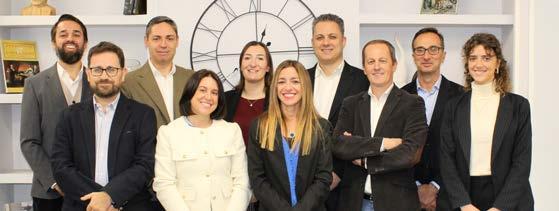

FertigHy was founded with the ambition to lead the transition towards low-carbon fertilisers in Europe. That ambition needed the right support at the right time. InnoEnergy has been a key partner in that journey—offering strategic support that goes far beyond funding, especially through access to top-tier talent, technical expertise, and a highly valuable network that has opened doors and accelerated our progress.
José Antonio de las Heras CEO, FertigHy
FertigHy is one of InnoEnergy’s company builders, founded together with industryleading shareholders along the energy and food value chains to decarbonise the fertiliser sector at scale. By integrating the production chain -from hydrogen to fertiliser- FertigHy will be able to provide a resilient operation, reducing dependency on imports and providing supply security and price stability to the market.
Mikel Monclús Investment and Asset Manager, InnoEnergy
€1.3B
Funding needs by 2030
Main contribution to UN SDGs
250 Jobs created when the plant is in operation
1M Forecasted emissions avoided by 2030 t CO2e




Low-carbon fertilisers produced by 2030


European Solar Photovoltaic Industry Alliance (ESIA)
ESIA aims to accelerate solar PV deployment in the EU by scaling up to 30 GW of annual solar PV manufacturing capacity in Europe in 2025, facilitating investment, de-risking sector acceleration, and supporting Europe’s decarbonisation targets.
Launched by the European Commission in 2022, InnoEnergy is leading the alliance as its Secretariat. SolarPower Europe and the European Solar Manufacturing Council are on the alliance’s steering committee.
To deliver the EU Solar Strategy objectives, the alliance will re-develop, de-risk, and accelerate the PV industry in Europe across all value chain segments. This will create a competitive position in the context of booming demand for solar PV in Europe and globally.
The alliance’s main focus is on:
• The financing of European solar PV manufacturing projects, ensuring a sustainable level playing field.
• Swift implementation of ecodesign requirements for PV systems and products.
• Anticipating the skills requirements of this new industry with the start of the European Solar PV Industry Alliance Academy. PHOTOVOLTAICS
News & developments
ESIA welcomes the signing of the European Solar Charter. Europe commits to photovoltaic industry recovery →
ESIA publishes its 2024 Action Plan →
Commissioner Breton hosts ministerial meeting on European Solar PV Industry Alliance →
Upcoming Innovation Fund Calls: Empowering Innovation in the European Solar PV Industry →

€40B
Annual market value
400K
New jobs
The European Solar PV Industry Alliance (ESIA) represents a pivotal effort to position solar PV not only as a cornerstone of the energy transition, but also as a strategic driver of European industrial growth and prosperity. Over the past two years, ESIA has made great progress in re-establishing Europe’s leadership in solar PV manufacturing - from launching key industrial projects to mobilising billions in investment and aligning stakeholders across the entire value chain. This is how ambition becomes action, and how Europe regains its place at the forefront of the clean energy revolution.
Javier Sanz Thematic leader, Renewable energy






















2

Reflecting on the European Commission’s support for the solar industry, Kerstin Jorna remarked ESIA’s work is “a game-changer in the way the European Union is functioning, as its Governments and the European Commission work together as an executive on the business case for the industry.
Kerstin Jorna Director-General, European Commission, DG GROW
Value chain actors and the number of ESIA members active in the value chain segments.

Holosolis

PV made in Europe: powering Europe's solar sovereignty
www.holosolis.com
Holosolis is poised to play a pivotal role in restoring Europe’s energy sovereignty by launching the continent’s largest solar photovoltaic manufacturing facility (5GW).
Due to COVID-19 supply chain disruptions and the Russia-Ukraine energy crisis, the EU's momentum to reduce dependence on Chinese imports has intensified. Supported by new regulations and funding, Holosolis brings together a seasoned management team and an ecosystem of top-tier partners to localise the entire PV value chain, strategically aligning with Europe’s economic and environmental goals.
By 2030, Europe's demand for photovoltaic modules is projected to reach 40-50 GW annually, representing a €10-12B market. Today, most panels are imported from China, leaving the EU vulnerable to external shocks. Holosolis is ideally positioned to fill this gap, offering a secure, high-quality, and scalable alternative. As one of Europe's most advanced gigawatt-scale solar projects, the company is set to capture significant market share and become a cornerstone in the EU's clean energy future.
Holosolis leverages state-of-the-art TOPCon technology to deliver solar cells with superior energy efficiency and performance. Its manufacturing platform is designed for flexibility, enabling integration of next-generation PV technologies as they emerge. This ensures long-term competitiveness against global players, while supporting Europe's ambition to lead in renewable energy innovation.
News & developments
Photovoltaic producers mobilised around HoloSolis →
Holosolis, backed by InnoEnergy, launches Europe’s largest solar PV gigafactory to boost EU energy security → ARMOR GROUP: a new shareholder for the company HoloSolis →



Holosolis contributes to European energy sovereignty and reindustrialisation by building a 5GW solar cell and module manufacturing plant. InnoEnergy, as founder and shareholder, is critical in realising this ambition by putting its extensive and in-depth knowledge of the entire value chain, including industrial and financial partners, at our disposal.
Bertrand Lecacheux CEO, Holosolis
Holosolis was created in 2022 with the great ambition to re-shore the European manufacturing chain for PV cells and modules. Ever since, the company has worked tirelessly towards this goal. The company has already reached key milestones in the project's development, such as site selection, electrical connection validation and first permitting phases. InnoEnergy is proud to support the company in realising its goal of contributing to the production of 10 million solar panels a year by 2030. This will, in turn, drive the avoidance of 14 mtCO2, create 2,000 jobs and contribute significantly to the key priority of EU energy independence.
Charlotte Triquigneaux
CFO France, InnoEnergy, and Board Member, Holosolis
€8.75M
Funds raised by 2024
Main contribution to UN SDGs
5GW
Production for 2030 14M

Forecasted emissions avoided by 2030 t CO2e





ECOSYSTEM
Connecting it all for impact.
Transitioning into clean energy requires going far and together. That is why we built the world's largest and most trusted ecosystem for clean tech innovation. The final layer of our innovation system is our ecosystem that connects all layers and people to drive a net-zero economy.
Our ecosystem brings together 1,400+ entrepreneurs, investors, industry leaders, policymakers, and academia across 21 EU member states, the US, and Asia to accelerate the clean energy transition. Our holistic approach is anchored in our partnership with the EU and its institutions
By collaborating across borders and sectors, we bring everyone closer, enabling meaningful connections, trust-based cooperation, and drawing on the power of our collective intelligence.

Most importantly, we need collaboration. Schneider alone cannot make it happen. InnoEnergy’s startups, large companies, politicians, and the entire ecosystem must work together in this direction.
Gwenaelle Avice Huet Executive Vice President, Europe Operations, Schneider Electric

39 Shareholders 1.4K Partners overall 2,000+ Master & PhD alumni

200+ Clean-tech VC’s worldwide
540+ Start-ups supported* * Accumulated
15 Research institutes
200+ InnoEnergy team

160+ Active portfolio companies
16 Top technical universities
04 OUR PORTFOLIO


Our portfolio strategy is built around high-potential technologies and business models that align with the energy transition. It includes mainly capital-intensive deep tech, but also IoT and AI-driven solutions to complete the energy transition. Focusing on key thematic areas and critical industrial value chains ensures our investments drive systemic change across industries and deliver long-term value for the economy, society, and environment.
Matias Torrellas Head of Portfolio Management, InnoEnergy
Innovation sparks it. Investment fuels it. Industry builds it.

InnoEnergy’s equity holdings are managed following a portfolio management approach to maximise the economic, societal, and environmental return given the chosen risk level. The risk taken is commensurate with a portfolio of early-stage and scale-up companies in sustainable energy. We invest mainly in disruptive, high-capex technologies, but we also include in our portfolio capexlight business models, often involving IoT and Artificial Intelligence (AI), which are also needed to complete the energy transition. The expertise of our teams and partners helps us de-risk both types of companies.
We classify companies in our portfolio across seven thematic fields: Renewable energies, Energy storage, Smart electric grid, Energy efficiency, Decarbonising industry, Energy for transport and mobility, and Energy for circular economy. For each thematic field, we have designed a strategy that considers our vision of the market needs and opportunities to achieve the energy transition targets set by the EU. Within each thematic field, we focus on the sub-sectors in which we believe the best market opportunities reside. In addition, we focus on three industrial value chains critical for the energy transition: batteries, green hydrogen and PVs, to help re-establish the complete value chain for these industries in Europe.
ADDRESSING CURRENT TRENDS
AI’s double impact on energy efficiency and transition
As the global energy landscape accelerates toward net-zero, digitalisation, data, and AI are becoming central pillars of innovation across the climate tech and sustainable energy sectors. From predictive analytics to autonomous operations, AI enables smarter, faster, and more adaptive energy systems. The sector increasingly relies on intelligent tools to optimise grid efficiency, integrate renewable sources, and accelerate decarbonisation.

At the same time, this digital transformation brings its own set of sustainability challenges. The exponential growth of data, and with it, data centres, is driving a significant increase in electricity demand. Already, data centres are responsible for an estimated 1-2% of global electricity use; a figure set to rise sharply. Importantly, up to 40% of that energy goes to cooling alone, and over 90% of the total electrical energy consumed ends up as waste heat.
At InnoEnergy, we recognise both the opportunity and the responsibility embedded in this dynamic. That is why we invest in pioneering companies offering breakthrough solutions to one of the sector’s hottest challenges: data centre cooling. Our portfolio companies are turning thermal waste into circular energy flows, using recovered heat for efficient cooling
systems, or repurposing it for adjacent industrial or residential applications. These innovations not only reduce emissions but also help mitigate the energy footprint of digital infrastructure itself.
On the other side of the equation, we firmly believe that advanced AI is an indispensable enabler of the energy transition. From mining critical minerals using AI-driven geological models to designing new synthetic materials for clean tech and managing real-time grid demand with precision forecasting, AI is embedded across the value chain. Our portfolio companies offer a broad range of innovative solutions with AI at the core.
As both a driver of demand and a force for transformation, AI sits at the crossroads of climate and technology. We are committed to supporting solutions that ensure this technology evolves sustainably, unlocking its full potential for a cleaner, smarter energy future.
- Frank Gielen Education Director, InnoEnergy

Boosting data centre efficiency with advanced rotation heat pumps
In data centres, the exceptional cooling capability of the rotation heat pumps can be used very effectively. Because the rotation heat pump does not take up the heat from the source in an evaporation at a fixed temperature but in a so-called glide while maintaining the gas phase, it can cool down a heat source (i.e., the waste heat from the data centres servers) much more efficiently than a conventional compressor heat pump.
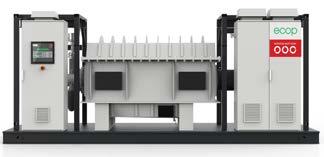
For example, assuming a cooling efficiency of 4 (cold production divided by used electrical energy) and a cold production of 1MW at a typical temperature of the cooling cycle in a data centre of 32°C/18°C, the rotation heat pump can produce around 1.3MW heat at 85°C with only 83kW more electrical energy consumption in comparison to a conventional chiller whose waste heat is typically released into the environment at ~45°C via roof-mounted re-coolers.

With its powerful ecosystem that includes many essential players in the data centre universe, InnoEnergy is supporting us meaningfully in the endeavour to demonstrate our new technology in a data centre application. With our participation in the InnoEnergy data centre events in Warsaw and Paris, and through direct connections by the InnoEnergy team, we also gained many important contacts that have already translated into concrete project leads.
- Fabian Sacharowitz CEO, ecop

THE DUAL-USE FRONTIER
Clean tech’s strategic role in energy and defence transformation
The growing convergence of technology and innovation in the energy transition, reindustrialisation, and the security sector sparks a resurgence of "dual-use": technologies and products that can serve both civilian and defence/security applications.

National security agencies in Europe and the United States (DOD, MOD), NATO, and similar entities increasingly recognise cleantech as critical to geopolitical resilience and stability. As an example, GDI collaborates with the Department of Defence to develop and deliver non-combustible powerpacks. Enabled by their silicon anode technology powerpacks will be safe even when punctured. Energy security in a dual-use context for onshore and offshore renewables changes; thus, innovations that monitor and survey critical energy infrastructure are at the heart of this market space. Hepta Insights offers dual-use capabilities by digitising and monitoring critical energy infrastructure, including assets near national borders. Its AI-enhanced platform enhances energy networks' resilience and situational awareness, supporting civilian reliability and strategic defence needs.
The European-based NATO fund and the recently announced European Defence Fund (EDF) help to accelerate the market space in Europe, fuelling a growth of dual-use / defence-oriented funds with new and incumbent names, including Keen Venture partners, Lakestar, Scalewolf, and many others. While the clean tech capital market is scrambling to follow the pace of change and does so stumbling over exclusion criteria, often deeply rooted in the investment thesis and ESG principles governing the funds, which in itself becomes a market where placement agents like Worthwhile Capital Partners are providing service to help transition towards dual-use inclusiveness.
The intersection between civilian and defence, dual use, and security is an emerging opportunity that the market is rapidly learning to embrace. New markets and joint developments contribute not only to a broader set of opportunities for innovators to de-risk their innovations and commercialisation but also create new opportunities in capital markets.
- Alexander Goos Head of Asset Management,
InnoEnergy


Digitising and monitoring critical energy infrastructure
Hepta Insights offers dual-use capabilities by digitising and monitoring critical energy infrastructure, including assets near national borders. Its AI-enhanced platform enhances the resilience and situational awareness of energy networks, supporting both civilian reliability and strategic defence needs.

Ukraine-related projects: Hepta is committed to supporting the modernisation and resilience of Ukraine’s energy infrastructure. Leveraging our expertise in AI-enhanced infrastructure analysis and predictive maintenance, we contribute to restoring and strengthening Ukraine's power grid. While specific partnerships with Ukrainian power line operators are under discussion, our focus remains on delivering scalable, technology-driven solutions that align with Ukraine’s long-term energy security and modernisation goals.

InnoEnergy has played a valuable role in supporting Hepta’s growth and strategic alignment. As we begin exploring the dual-use potential of our infrastructure intelligence platform, InnoEnergy’s network and visibility provide critical leverage to position our technology in defence-relevant contexts, especially where energy security and infrastructure resilience intersect.
Henri Klemmer CEO, Hepta
UN SUSTAINABLE DEVELOPMENT GOALS
UN SDGs contribution
As part of InnoEnergy’s commitment to making a positive impact on the energy sector, the environment, the economy, and society, we assess the contribution the companies in our portfolio make to SDGs.
Given that SDGs 7 and 13 have a direct link to InnoEnergy’s strategic goals of reducing CO2 emissions, increasing the security of energy supply, and lowering costs along the value chain, it is no surprise that most of the innovations we support contribute to SDGs 7, 8, 9, 11, 12, and 13.
OUR PORTFOLIO COMPANIES BY THEMATIC FIELDS

















Energy for the Circular Economy
The energy for the circular economy thematic field includes bioeconomy opportunities, waste recycling and valorisation solutions, and CCUS (carbon capture, utilisation, and storage). These sectors play a crucial role in the clean energy transition through the smart application of circular economy principles.
In the context of the EU's circular economy policies, thematic field initiatives are essential for shortening supply chains, reducing import dependencies, and achieving climate and environmental goals. By focusing on high-added-value cases such as clean fuels and e-fuels, recycling and materials recovery, waste logistics, advanced biobased solutions, and substitutes for fossil-derived products, we aim to foster new market opportunities. This approach supports decarbonisation and enhances competitiveness by promoting sustainable and innovative solutions.
We are encouraging innovation that:
• Develops substitutes for fossil-derived products and energy carriers
• Provides new solutions for the valorisation of various waste and byproduct streams
• Ensures the comprehensive application of circularity principles within the bioeconomy
• Meets the demand for sustainable and dispatchable heat
• Creates opportunities for carbon capture and utilisation Challenges:
• Lack of scalable technologies: Many energy recovery and circular processes are still under development or not cost-effective at scale
• Efficiency limitations: Energy recovery from materials still suffers from low energy yield and conversion losses
• High upfront costs: Circular energy systems often demand substantial capital investment
• Unpredictable waste streams: Circular systems depend on the consistent quality and quantity of feedstock

InnoEnergy’s portfolio of companies in the field of Energy for the circular economy is expanding, and the EU’s policy targets are crucial for addressing two of Europe's most pressing challenges: the transition to net-zero and the restoration of economic competitiveness. By fostering innovative solutions in bioeconomy, carbon capture and utilisation, and waste valorisation, we are not only driving decarbonisation but also enhancing the resilience and sustainability of industries. This dual focus ensures that we are paving the way for a cleaner, more competitive future for Europe.
Marcin Lewenstein
Energy for the Circular Economy Thematic Leader, InnoEnergy
BIOECONOMY WASTE SOLUTIONS CARBON TECH + LOW-C SOLUTIONS


























ROSI
Circular economy for the PV industry
www.rosi-solar.com
High purity and quality PV recycling with 90% impact savings
ROSI's recycling process, which extracts high-purity raw materials from end-of-life PV panels, has proven to have a 90% impact savings compared to conventional production activities. The recycling process keeps the raw material’s purity high, creating new and locally available secondary raw material sources.
End-of-life PV modules are expected to reach 78 million metric tonnes globally by 2050. Around 1900 GW of PV capacity is installed worldwide, with an annual average of a 20% installation growth rate. PV panels installed 20-30 years ago are beginning to reach their end-of-life and need to be replaced. Recycling them provides a tremendous opportunity to reuse raw materials such as copper, silver, aluminium, and the critical raw material silicon, reducing emissions and boosting Europe’s resource independence.
ROSI’s proprietary technology recovers up to 99% of precious materials, such as silver and ultra-pure silicon, from discarded photovoltaic panels, far exceeding current recycling norms. The first recycling plant in Grenoble, has proven ROSI’s recycling process and closed the commercial value chain. Automation will further reduce the cost. With the developments and being first of a kind, delivering substantial ESG impact, ROSI plays a crucial role in closing the loop for the PV industry.

€20M
Funds raised
85.1K
Forecasted emissions avoided by 2030
5
Recycled as of 31 december 2024 t CO2e t



InnoEnergy has been playing a crucial role in ROSI’s development. As a deeptech startup in the energy sector, fundraising and market access are two tough topics. Under whatever situation, InnoEnergy has always believed in us, especially during the fundraising phase. I am especially grateful that InnoEnergy brought ROSI to the European Commission and put PV recycling with purity and quality on their agenda. Now ROSI is recognised as a PV recycling pioneer thanks to InnoEnergy.
Yun Luo
CEO and Co-Founder, ROSI

ROSI is tackling one of the most pressing and often overlooked challenges in the global energy transition: the looming surge in solar waste. What sets ROSI apart is not just that they recycle photovoltaic panels but the unparalleled quality and purity of the materials they recover. Their advanced technology captures up to 99% of critical components like high-purity silicon and silver, transforming end-of-life PV modules into valuable, reusable resources, a true game-changer for the industry. With its first fully operational plant in France already demonstrating this breakthrough at scale, and plans to expand globally in the coming years, ROSI is poised to redefine how the world manages solar waste. We're proud to support a company at the forefront of this critical shift, turning waste into a valuable resource for the future of clean energy.
Gianmarco Panone Investment and Asset Manager, InnoEnergy
News & developments
ROSI partners with Waste Experts and CEF to recycle solar panels in the UK → AGC Glass Europe and photovoltaic recycling pioneer ROSI announce strategic partnership to advance circularity in the glass industry →
ROSI selected to join the EIC Scaling Club as one of Europe’s highest-potential deep tech scale-ups →
Main contributions to UN SDGs





Energy Efficiency
Energy efficiency is a cornerstone of clean technology and a critical enabler of global decarbonisation goals. Today, significant progress has been made in sectors like buildings, transport, and manufacturing through innovations such as smart grids, electric vehicles, heat pumps, and AI-driven energy management systems.
However, overall efficiency gains are not yet scaling fast enough to meet climate targets. Barriers include outdated infrastructure, fragmented policies, and high upfront costs. While clean tech offers immense potential to cut energy waste and optimise performance, accelerating adoption requires stronger regulatory support, incentives, and collaboration across industries to embed efficiency into every stage of energy use.
Buildings and industry accounts for more than 50% of the EU's energy consumption, and at least 33% of its CO2 emissions. Reducing energy consumption at home and work is still the most cost-effective way to reduce carbon emissions and improve energy security and competitiveness.
We are encouraging innovation in large and small-scale storage that will:
• AI-driven platforms optimise energy use in real-time by analysing consumption patterns and predicting demand to minimise waste and enhance efficiency
• AI-driven platforms for predictive Analytics & Automation to anticipate energy needs, real-time optimisation, and adjust operations proactively for reducing energy usage
• High-performance insulation and materials
• Thermal systems and equipment (e.g., electric boilers, induction heating)
• Electrification of components and system solutions for industrial applications
• Technologies and business models enabling and exploiting behavioural changes Challenges
• According to the World Bank, a lack of awareness among consumers, businesses, and policymakers is a significant challenge to adopting energy efficiency
• Initial cost of investing in energy efficiency technologies
• A lack of competencies and skills can slow down the adoption of new energy solutions
• Integration with existing systems. Retrofitting older buildings or industrial facilities can be complex and costly due to outdated infrastructure, which can hinder the adoption of smart technologies
THERMAL SYSTEMS & EQUIPMENT




OTHER



ELECTRIFICATION COMPONENTS & SYSTEMS









Stockholm Water Technology (SWT)
Smart and sustainable water purification
www.stockholmwater.com
1.49M
CO2e
Forecasted emissions avoided by 2030
€4M
Energy savings
77B
Litres of water savings by 2030
50% higherwater recoverywith 30% lower energy use
Stockholm Water Technology's (SWT) patented electro-capacitive. water cleaning technology includes software-tailorable water quality. capabilities. This.significantly.reduces the.energy.consumption for water. treatment and generates unprecedented application-specific flexibility It.is.also.common.for.SWT.products.to.have.up.to.50%.higher.water. recovery,.30% lower.energy.use, massively.reduced.chemical.usage, the. capability.to.recover.nutrients.from.waste,.and.complete.autonomy.in. operation,.which.brings.lower.OPEX.costs.
The serviceable obtainable market (SOM) for SWT in phase 1 (until. 2030) is approximately €27B, spanning the industrial, municipal, and. consumer.markets..Phase.1.is.focused.on.building.sales.and.customer. success.traction.in.Europe,.the.Middle.East,.and.India.for.wastewater. recycling.in.inland fish farms,.municipal wastewater.plants,.and.specific. industries. This.phase will.also focus.on.capturing.a.good.portion.of the. consumer.and.commercial.market.in the.Middle.East.and.initial traction. in the Indian market. Moving into phase 2, SWT will serve municipal and. industrial.projects.with.an.SOM.of.over.€50B,.with.planned.expansion. into.the.Americas.
After the successful commercial deployment of the smaller STRÖM. unit in 2022 and building in-house manufacturing expertise, SWT is. now.scaling.up.and.introducing.its.larger.system,.FORS,.to.service.the. needs.of.medium.industry.and.small.municipality.projects..SWT.is.also. working.on.automating.and.increasing.its.production.capacity.to.meet. projected sales requirements in the coming two years. By Q4 2026,. the.full-scale.industrial.system.will.be.introduced,.capable.of.serving. municipal-level.applications.on.a.global.scale.




SWT is a pioneer in developing and integrating a fully electric and chemical-free water cleaning solution. Our vision is not just to bring a more efficient and highly intelligent water treatment technology to the market, but rather to bring about a paradigm shift in how water treatment is perceived and implemented in the smart cities of tomorrow.
This transition requires patient capital, partners, and customers who share our vision and believe in securing the future of clean water. SWT is lucky to have found such a partner in InnoEnergy, who has been with us from day 1, worked with us in finding the right customers, and supported SWT at critical times with patient capital. With the backing of our partners, we are now bringing our scaled-up system to our customers in France and Saudi Arabia to recycle and reuse wastewater and set the trend for future water sustainability.
Karthik Kunjali
Co-Founder and CEO, Stockholm
Water
Technology

The water scarcity in the world is an increasing challenge, and almost 2 billion people are experiencing absolute water scarcity. The SWT technology offers a future-proof solution to water treatment for many applications and contaminants, tailored to customer needs through software control. At InnoEnergy, we are proud to support SWT in driving impact, becoming a true global company in sustainably cleaning water. A win-win solution.
Jonas Nordlund Investment and Asset Manager,
InnoEnergy
News & developments
Stockholm Water Technology to enable clean and drinking water in Saudi Arabia → From waste to drinking water → Beneath the surface - SWT Innovations in Water Treatment for Aquaculture and Aquaponics →






Energy Storage
Two major societal trends drive the development of energy storage: the decarbonisation of the transportation sector and the addition of stationary storage to the electricity grid. Both trends have had a major impact on the extremely fast-developing Li-ion battery and the entire value chain.
Europe highly depends on a clean and reliable value chain to supply low-carbon intensity batteries for the automotive industry. With the accelerating need for balancing resources in the grid, longer-duration storage solutions become increasingly important. All developments must be done in a very competitive climate, where cost levels have been pushed down to unimaginable lows compared to just two years ago
We are encouraging innovation in large and small-scale storage that will:
• Find clean and cost-effective solutions for battery cell manufacturing
• Introduce new battery technologies beyond the lithium-ion chemistry
• Find cost-effective solutions for long-duration energy storage
• Explore cost-effective recycling solutions for all parts of the battery value chain Challenges
• Completing the European battery value chain primarily upstream
• Innovative battery and energy storage technologies beyond the Li ion technology
• Cost-effective recycling technologies for the entire value chain
• Technical and regulatory solutions for long-duration energy storage
• Alternative energy storage business models
• Long duration energy storage enabling 24/7 renewable electricity supply

Energy storage plays an increasingly essential role in ensuring the successful deployment of wind, solar, and ocean renewables. It is also vital in managing the new loads on the grid. Energy storage technologies are central to furthering the energy transition and phasing out fossil-based resources.
Johan Söderbom Energy Storage Thematic Leader, InnoEnergy
LITHIUM-ION BATTERY VALUE CHAIN






INNOVATIVE BATTERY AND ENERGY STORAGE TECHNOLOGIES













ALTERNATIVE ENERGY STORAGE BUSINESS MODELS




Altris
Batteries from salt, wood, iron, and air
www.altris.se
Long life, flexible working temperature, and safe batteries
Altris’s sustainable, commercial-sized sodium-ion battery cell has proven an energy density of 160Wh/kg and has a capacity of over 160 mAh/g, the highest capacity of its kind. The cell is made from their patented Prussian White cathode material, comprising entirely of abundant raw materials (salt, wood, iron, and air).
Altris’s cell for batteries has applications ranging from low-voltage batteries to Battery Energy Storage Systems (BESS) and maritime. The sodium-ion battery market accounted for around USD 1.17 B in 2024 and is expected to grow to at least USD 6.83 B by 2034, with the supply side currently far from reaching the forecasted demand.
Forecasted emissions avoided by 2030 t CO2e
The pilot production will enable the commercialisation of Altris’s sodium-ion technology and is expected to be operational in 2027. Their patented NaBOB electrolyte is a fire retardant, and the patented low-temperature and pressure synthesis route provides a sustainable alternative and improves performance. The technology, patented materials, and production process keep the production costs comparably low. €26M
Funds raised by 2024
Direct jobs created by 2024



Spearheading sodium-ion battery technology, Altris is not just innovating for performance—we’re working to redefine scalable, sustainable energy, and make it cost-competitive. That takes more than great chemistry; it takes partners who know how to build real companies in deep tech and who share our urgency to drive the energy transition forward.
InnoEnergy has been one of those rare, catalytic partners. From day one, they’ve contributed far more than funding: bringing access to strategic networks, deep domain expertise, and the kind of credibility that opens doors in both industry and policy. Their ability to connect innovation with industrialisation has played a critical role in our journey.
Today, as we ramp up production and work with global leaders to bring sodium-ion to market at scale, InnoEnergy remains a core part of our story—helping turn breakthrough science into impactful, realworld solution.
Christer Bergquist CEO, Altris

Altris has achieved what many thought was years away—developing a truly sustainable sodium-ion battery with performance that stands up to real-world demands. What impressed us early on wasn’t just the chemistry, but the team’s clear focus on scalability, safety, and industrialisation. Using abundant materials like salt and iron to create high-performing cells is exactly the kind of innovation Europe needs to lead the energy transition. Now with three new strategic investors and partners, Altris move from pilot to commercial scale, Altris is a key player in reshaping the global battery market.
Magnus Lundin
Investment Director Scandinavia, InnoEnergy
News & developments
Altris and Volvo Cars join forces to advance sodium-ion battery technology → Altris secures 150 MSEK Series B1 funding and welcomes new strategic investors → Altris and Stora Enso in partnership to develop hard carbon anode material for sodium-ion batteries →
Main contributions to UN SDGs






Smart Grid
As the energy transition progresses, the electric grid is increasingly exposed to new challenges, including the rapid deployment of renewable generation and new loads such as electric vehicles and heat pumps.
These developments stress both transmission and low-voltage distribution. To cope, it will be necessary to utilise smart grid technologies, existing and new flexibility resources, and develop the market and regulatory frameworks.
We are encouraging the development of new solutions that:
• Make existing flexibility resources available for balancing the grid
• Increase the visibility in the low-voltage grid to enable fast reactions to load variations
• Provide data and information management to optimise and better utilise the existing infrastructure Challenges
• Better utilisation of the existing grid infrastructure
• More efficient grid edge solutions to increase the capacity of the low-voltage grid
• Market design and regulations that allow for smarter solutions in the electricity grid

To ensure the grid supports the energy transition in its next phase, we must find ways to integrate renewable energy generation into the existing grid system. This is done by providing flexible software and hardware solution technologies that enable the grid to operate more efficiently and optimally. We also encourage new business models where the end-user contributes to the energy transition, including microgrids.
Johan Söderbom
Leader, InnoEnergy
SMART ELECTRIC GRID INFRASTRUCTURE SYSTEMS AND SERVICES





GRID EDGE TECHNOLOGY AND ENERGY SHARING SOLUTIONS



MARKET DESIGN OPTIMISATION


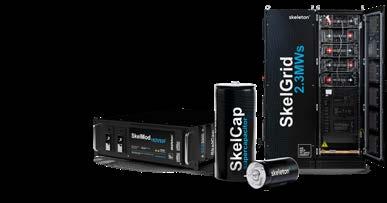
Skeleton Technologies
Grid-scale high-power energy storage
www.skeletontech.com
2x higher power density and a 50% smaller footprint
Skeleton offers a top-end supercapacitor for the grid based on its patented electrode material, Curved Graphene. Compared to the competition, the Skeleton supercapacitor has a small footprint and high power density.
As more of the generation in the grid comes from solar and wind instead of large, heavy rotating generators in fossil power plants, the inertia in the systems decreases. The consequence is a grid that is more sensitive to short disturbances. A way to stabilise the grid is to deploy high-speed energy storage systems. An alternative to batteries is supercapacitors, which can handle extremely high powers (fast charge/discharge) and last for 100 of thousands of cycles.
1.3M
Forecasted emissions avoided by 2030 t CO2e
317
Direct jobs created by 2024
Skeleton currently produces in Estonia and Germany and is expanding with new production in Germany and France. Apart from the market for grid support, Skeleton is targeting all applications where fast electric energy recovery or multiple quick power bursts are in demand. This can be Kinteic Energy Recovery Systems (KERS) in vehicles, evening out power demand in datacentres, or ICE engine start systems. €338M
Funds raised by 2024


InnoEnergy has been an extremely valuable strategic partner for Skeleton Technologies and its impact goes way beyond being an investor. InnoEnergy has been instrumental in our business development, and we have been closely collaborating with InnoEnergy’s offices – whether in Scandinavia, Poland, Germany or France – to increase our outreach to local companies. The InnoEnergy team is particularly active in matchmaking with businesses and investors, and in organising events that will benefit all companies in their portfolio. When you are part of InnoEnergy, you are part of a wide community and network, so you can easily access leading industrial companies in Europe.
Taavi Madiberk CEO and Co-Founder, Skeleton Technologies

Skeleton is redefining what is possible in high-power energy storage. Its patented Curved Graphene technology brings breakthrough performance and a real solution to one of the energy transition’s most critical challenges: grid stability. As electricity systems shift rapidly toward renewable generation, ultra-fast, durable storage like Skeleton’s supercapacitors becomes essential. We have supported Skeleton from early development to industrial scale, and what stands out is their vision, ability to execute, and commitment to in-house engineering for continuous growth.
Lowina Lundström CEO Scandinavia, InnoEnergy
News & developments
Skeleton Technologies expands R&D capabilities with new unit in Finland → Skeleton Technologies' Supercapacitors Power New IndyCar Hybrid System →
Siemens Employs Skeleton’s Supercapacitors in Smart Power Management for Industrial Machinery →






Renewable Energy
Renewable energy sources, including solar, wind, and ocean energy, are essential for reducing our dependence on fossil fuels and achieving energy security and autonomy.
The EU is leading global efforts to decarbonise the economy, with clear targets enshrined into law under the European Climate Law. This has already created strong demand for decarbonised products across Europe.
The EU's Industrial strategy, set out in the Green Industrial Plan and now the Clean Industrial Deal is the other piece of the puzzle. It ensures that this demand is met with European supply by building domestic industrial capacity to ensure resilient supply chains and that citizens also benefit from the transition.
We are encouraging innovation that:
• Improves the production, penetration and profitability of power generation through renewable energy
• Continues to develop all forms of solar technology, with a special focus on the upstream part of the value chain (from quartz to modules)
• Improves reliability, accuracy and integration of onshore and offshore wind
• Increases performance, lifespan and scalability of wave power
• Hybridisation between renewable energy power generation technologies, including energy storage, to solve the intermittency
Challenges
• To continue lowering LCOE, as this is the main driver for competitiveness
• Incorporating recycling of materials as a way to overcome shortages for critical materials and enhance environmental sustainability
• Extension of life and decommissioning for mature technologies (i.e., wind, solar)
• Consolidate market entry for new technologies (i.e., floating wind, ocean energies)
• New manufacturing technologies (i.e., additive manufacturing) that can enhance the production yield)

Latest development, starting with the pandemic, followed by the war close to our borders, and lately because of the global economic war, shows how important it is to have energy sovereignty and independence. These effects add to the need for a strong reaction to tackle the climate crisis. An increasing number of countries and economic regions are committing to reaching climate neutrality by 2050, thereby limiting the rise in global temperatures to 1.5°C. As a fundamental pillar for the decarbonisation, renewable energies will play a major role, and for that purpose, leading their development, including the industrial dimension, is vital.
Javier Sanz
Renewable Energy Thematic Leader, InnoEnergy

WAVE




TIDAL & CURRENT



SOLAR THERMAL


















24/7 clean, time-matched power
SeaQurrent’s patented multi-wing TidalKite™ system, a groundbreaking technology that '3D-harnesses' energy from tidal and ocean currents, capturing up to 3x more energy than other tidal technologies. The TidalKite system generates baseload power at a competitive cost, complementing solar and wind energy, and generating higher energy revenues per kWh than intermittent renewables.
The tidal energy market is gaining significant traction as a vast, predictable energy source. With the potential to generate over 2100 TWh/year globally, tidal energy offers a substantial opportunity to provide clean power to hundreds of millions of households and businesses. The global tidal energy market is growing and expected to be around USD 4B by 2033, with a CAGR of 14% from 2026 to 2033.
SeaQurrent’s TidalKite technology is eco-friendly, recyclable, and suitable for all tidal segments. It also simplifies deployment, requiring less complex infrastructure than earlier generation tidal barrages and turbines. The system has been successfully demonstrated in real-world conditions, with technology development at TRL 7 and permits secured.
264.4K
Forecasted emissions avoided by 2030 t CO2e
€9.9M Funds raised by 2024
65.5
Forecasted clean energy generated by 2030 GWh



As pioneers in tidal energy, we’re building more than breakthrough technology: we’re shaping a new class of predictable, baseload renewables. That calls for more than capital; it requires partners who understand the realities of scaling deep-tech and navigating the energy transition.
InnoEnergy has been precisely that kind of partner. Their ecosystem goes far beyond funding, delivering strategic value through IP support, access to talent, expertise and reputation, and a highly relevant network. As Europe’s leading catalyst for clean tech innovation, they’ve played a key role in accelerating our progress— and continue to do so.
We’re now developing a commercial demonstrator and preparing to roll out TidalKite farms, marking an important step toward our ambition: making TidalKite a global, mainstream solution delivering 24/7 clean energy.
Maurits Alberda
Co-Founder and Chief Commercial Officer, SeaQurrent

"SeaQurrent’s TidalKite technology offers several benefits over existing tidal energy solutions, attracting early adopters’ interest for its renewable baseload profile. The next step on their journey is following up their successful pilot with a post-pilot project in Ameland, the Netherlands, later this year, which we are supporting. The way SeaQurrent is unlocking the potential of predictable and continuous tidal resources is impressive, and right in time with global renewable energy demand forecasted to continue to rise.
Roel van Diepen
Investment Director Benelux, InnoEnergy
News & developments
New partnership between Iron Mountain Data Centers and SeaQurrent →
SHINES Project to Harness Tidal and River Energy Potential in North-West Europe → Successful 2024 Test Period at Ameland →
Main contributions to UN SDGs





Energy for Transport and Mobility
The transport and mobility sector is responsible for about one-third of Europe‘s energy consumption and one-fourth of its overall greenhouse gas emissions. The energy transition for transport and mobility is no longer just about the vehicle – it is about the system.
Europe's EV rollout exposes grid constraints, charging infrastructure gaps, and critical mineral dependencies. These challenges are now driving innovation: in bidirectional charging, battery circularity, energy-aware routing, and software-defined vehicles that optimise efficiency and user experience.
Beyond the road, non-road transport is stepping into the decarbonisation spotlight. Shorthaul aviation and maritime shipping are trialling battery-electric and hydrogen propulsion, while rail continues to expand its electrified footprint. Policy momentum, from the EU Green Deal to the Fit for 55 package, turns long-term commitments into near-term investment.
We are fostering innovations in:
• Value-driving systems and components
• Smart infrastructure
• Advanced software and platforms
Challenges
• There is a need to continue levelling the playing field in Europe with respect to mobility. The USA is strong in investments and valuations, and Asia is cost-competitive; both create challenges for the competition.
• New partnerships, synchronisation, and shorter development cycles (tech players and OEMs) are required to support the acceleration of software-integrated mobility solutions (creating increased energy efficiency and improved user experiences).

Gear up – the transition to electric vehicles in Europe is shifting from ambition to execution. Battery electric cars now consistently outsell diesel, and EVs are reaching mass-market acceptance (13.6% market share in the EU overall, 2024) in several European countries. With CO2 fleet standards tightening in 2025 and the 2035 phase-out of internal combustion vehicles on the books, automakers are racing to scale production, localise supply chains, and meet demand in an ever-shifting consumer environment. Europe’s mobility transition is entering a more complex, integrated phase – and the innovation opportunities have never been broader.
Jennifer Dungs
Energy for Transport and Mobility Thematic Leader, InnoEnergy
VALUE-DRIVING SYSTEMS & COMPONENTS








SMART INFRASTRUCTURE


ADVANCE SOFTWARE & PLATFOMRS





The world’s lightest 10 kW outboard motor
www.zparq.se/en
10 times smaller high-performance electric boat motor
Zparq’s patented Hyperflow™ cooling enables ultra-compact, high-performance electric drivetrains. The propulsion pod is up to 10 times smaller in volume and weight of conventional solutions, yet powerful and robust enough for recreational and commercial use. Thanks to its modular, scalable architecture, the same core technology can power applications from small leisure craft to ferries and workboats, laying the foundation for full-market electrification.
The shift to zero-emission marine propulsion is accelerating. In Sweden alone, leisure boats emit 174,000 tonnes of CO2 annually, nearly a third of domestic flight emissions, despite limited usage. Traditional two-stroke engines also release thousands of tonnes of unburned fuel and toxic gases into the waters. Zparq is positioned to lead this transformation with compact, clean, and efficient solutions.
Zparq is in the final testing phase of its first product, the Z10, a plugand-play outboard system for small leisure boats compatible with new vessels and retrofits. Commercial launch and scale-up preparations are underway.

5 .5M
Forecasted emissions avoided by 2030 t CO2e
€2.5M Funds raised by 2024



At Zparq, we are not just building an electric outboard motor; we are unlocking the potential to electrify the entire marine sector. Our compact, modular propulsion pod forms the foundation for a scalable product family covering everything from lightweight tenders to megawatt commercial vessels. The Z10 outboard is our first step. Radically efficient, ultra-compact, and about one-third the weight of traditional systems, it slashes emissions across operation and production.
InnoEnergy’s early support has been critical. While many investors shy away from hardware at the earliest stage, InnoEnergy stepped in with funding, strategy, and an ecosystem that genuinely understands what it takes to scale deep tech. That is the kind of partnership you need to change an industry.
Jonas Genchel CEO and Co-Founder, Zparq

Zparq’s Hyperflow™ cooling and propulsion technology is a gamechanger for marine electrification. What impressed us early on wasn’t just the engineering; it was the vision to tackle emissions across the full spectrum of boats, from leisure craft to commercial fleets. We have supported Zparq from prototype to preparing for commercial rollout, and we believe their tech will play a major role in shaping a cleaner, quieter future on the water, a sector that’s long overdue for decarbonisation.
Siimon Vaske Investment and Asset Manager, InnoEnergy
News & developments
Zparq's Z10 outboard motor wins Sustainable Product of the Year Award at the Stockholm Boat Show →
Zparq's boat motor - "smaller and more effective" (in Swedish) → Swedish electric boat motor backed by Santander InnoEnergy Climate Fund (in Swedish) →
Main contributions to UN SDGs





Decarbonising Industry
InnoEnergy works in decarbonising energy-intensive industries (EIIs) such as cement, steel, chemical and fertilisers, aluminium, glass, and refining.
These industries account for about 20% of greenhouse gas emissions in the EU and make up more than half of the energy consumption of the EU’s industry, all while employing more than 20% of the European manufacturing labour force. Enabling their transition to net-zero is key to ensuring Europe’s competitiveness and paving the way for decarbonising industry globally.
We are fostering innovations in:
• Electrification of industrial heat and industrial processes
• Circular material flows for recycling of aluminium, steel and glass
• Low and zero GHG emission cement and concrete manufacturing
• Electrochemical synthesis of fuels, fertilizers and chemicals
• E-molecules and E-fuels by power-to-x
• Digital twin and AI for monitoring, predictive maintenance, process optimisation, and efficiency
Challenges
• Capex-heavy technology developments requiring the entire value chain to work together from the start, public-private risk-sharing is critical to reduce uncertainty for investors
• A large part of the industry transformation’s success relies on policy support
• Unlocking demand for greener EU-made industrial products at competitive prices
• Skills required in these industries evolve rapidly, and staying competitive requires a highly qualified and specialised workforce

Decarbonising industry isn’t just about reducing emissions, it’s about future-proofing Europe’s industry, increasing its competitiveness and reducing EU’s strategic dependencies. Industry accounts for about a quarter of global CO2 emissions, and if we want to reach net-zero, we need to tackle EIIs. Innovations exist, but investment is needed to test, scale and derisk so that the right technology is used the right way in the right sector. An important success factor for these capex-heavy sectors is the ecosystem. The entire value chain must come together to transition our EIIs.
Alvaro Ramirez Santos
Decarbonising Industry Thematic Co-leader, InnoEnergy

We see more innovations to decarbonise industrial applications starting to form, which means technology is no longer a barrier. A critical success factor for these capexheavy projects is the ecosystem. The entire value chain must come together to transition out fossil-based energy sources.
Marcin Lewenstein
Decarbonising Industry Thematic Co-leader, InnoEnergy
HYDROGEN PRODUCTION & STORAGE





STEEL INDUSTRY


MINING & GEOPHYSICAL SERVICES FERTILISERS



INDUSTRIAL HEAT & HEAT PUMPS


CHEMICAL INDUSTRY



www.h2hysun.com
100% clean, off-grid, and costcompetitive green hydrogen
Hysun’s competitive advantage lies in its unique photo-thermo-catalysis process, which produces 100% clean hydrogen with zero emissions, unlike traditional electrolysis methods, which depend on grid electricity and are only up to 60% clean. Hysun’s system supports on-off transitions and operates off-grid, reducing capex and opex. It uses only 22l of water per kg of hydrogen (vs. 30l in electrolysis) and relies on abundant, non-conflict metals instead of costly platinum group elements. Hysun’s compact footprint—just 12,000 m² for an 18 kg/h plant vs. 38,000 m² for electrolysis—enhances deployment flexibility. It offers a scalable, cost-efficient solution with a target pricing of €2-3/kg.
Targeting the fast-growing green hydrogen market, Hysun provides flexible business models: turnkey delivery and transfer (BOOT) and longterm hydrogen sales (HPA). The company aims to build 20 plants by 2030 (15,000 tons/year), expanding to 90 by 2040 (1.5 million tons/year).
Hysun is commissioning its R&D prototype and advancing from TRL 4 to TRL 5. This stage focuses on real-world validation, paving the way for industrial deployment and strategic partnerships.
525
Forecasted clean energy generated by 2030 GWh
141.7K
Forecasted emissions avoided by 2030 t CO2e
€4M Funds raised



InnoEnergy has been a key enabler of our progress. Few players in the industry are willing to fund early-stage disruptive technologies, even though such innovation is essential to driving meaningful change in the fight against climate change. Beyond their early commitment, they bring exceptional professionalism, rigorous processes, and provide startups with access to teams and infrastructure rarely within reach at this stage. This support accelerates professionalisation, improves efficiency and competitiveness, and makes companies far more attractive to future investors. InnoEnergy is a true catalyst for impactful decarbonisation in industrial sectors.
Tatiana López
CEO and Co-Founder, Hysun

Hysun’s technology, characterised by its minimal reliance on critical raw materials, lower water consumption, and reduced infrastructure requirements, provides a significant technical and economic advantage. With a flexible go-to-market strategy and ambitious rollout plans, Hysun is uniquely positioned to spearhead the next wave of hydrogen deployment across various sectors and geographies. As both an investor and partner, we recognise the immense potential of Hysun to become a cornerstone in the global transition to clean energy.
Jordi Daunis Investment and Asset Manager,
InnoEnergy
News & developments
Hysun Installs First Renewable Hydrogen Prototype → BacToFuel project → The 100% Spanish and fully renewable hydrogen project →





Thank you!
We are proud to work closely with all of our portfolio companies, supporting them in their growth and fostering innovation for a more sustainable world.






Photographer: Torbjörn Bergkvist





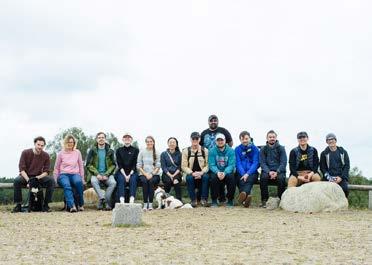
05 ANNEXES
InnoEnergy's equity portfolio


An idea is just an idea. Until it’s real.
COMPANY
THEMATIC FIELD
Athena Decarbonising industry
Beholder Decarbonising industry
Decarbonising industry
Decarbonising industry
Decarbonising industry
Decarbonising industry
industry
GravitHy Decarbonising industry






industry
COMPANY
THEMATIC FIELD






COMPANY
Methaplanet
Meva Energy
Nesetten
NitroCapt
Nordic SeaFarm
Nordluft Automation
Orchestra Scientific
Qurator
ROSI
Sadako
Stockholm Water T. (SWT)
Wohnwagon
&Charge
Atawey
Coat It
eCloudCompany
Elaphe
Hardt
Illicov
Incitis
THEMATIC FIELD
for the circular economy
for the circular economy
for the circular economy
for the circular economy
for the circular economy
the circular economy
the circular economy
the circular economy
circular economy
for the circular economy
for the circular economy
for the circular economy






Nuwiel
Routal
Scoobic
Swobbee
Tribonex
Waybler
Zeleros
COMPANY
THEMATIC FIELD












COMPANY THEMATIC FIELD






InnoEnergy
Kennispoort 6th floor
John F. Kennedylaan 2 5612 AB Eindhoven
The Netherlands info@innoenergy.com
InnoEnergy Benelux
Kennispoort 6th floor
John F. Kennedylaan 2 5612 AB Eindhoven
The Netherlands benelux@innoenergy.com
InnoEnergy Brussels
Rue Guimard 7 1040 Brussels info@innoenergy.com
InnoEnergy Central Europe
ul. Mogilska 43 31–545 Kraków, Poland central.europe@innoenergy.com
Transitioning global energy. Transforming every industry.
ul. Chmielna 73 00-801 Warszawa, Poland central.europe@innoenergy.com
InnoEnergy France
5 rue du Louvre 75001 PARIS, France france@innoenergy.com
5 place Nelson Mandela 38000 Grenoble, France france@innoenergy.com
InnoEnergy Germany
Albert-Nestler-Strasse 21 76131 Karlsruhe, Germany germany@innoenergy.com
Zionskirchstr. 73a 10119 Berlin, Germany germany@innoenergy.com
https://www.innoenergy.com/
InnoEnergy Iberia
Carrer Jordi Girona, 29 0C Nexus II building 08034 Barcelona, Spain iberia@innoenergy.com
Paseo de la Castellana, 259D, 18th fl. 28046 Madrid, Spain iberia@innoenergy.com
InnoEnergy Scandinavia
Torsgatan 11, 8th floor 111 23 Stockholm, Sweden scandinavia@innoenergy.com
InnoEnergy USA
444 Somerville Ave
Somerville, Massachusetts 02143 United States usa@innoenergy.com
